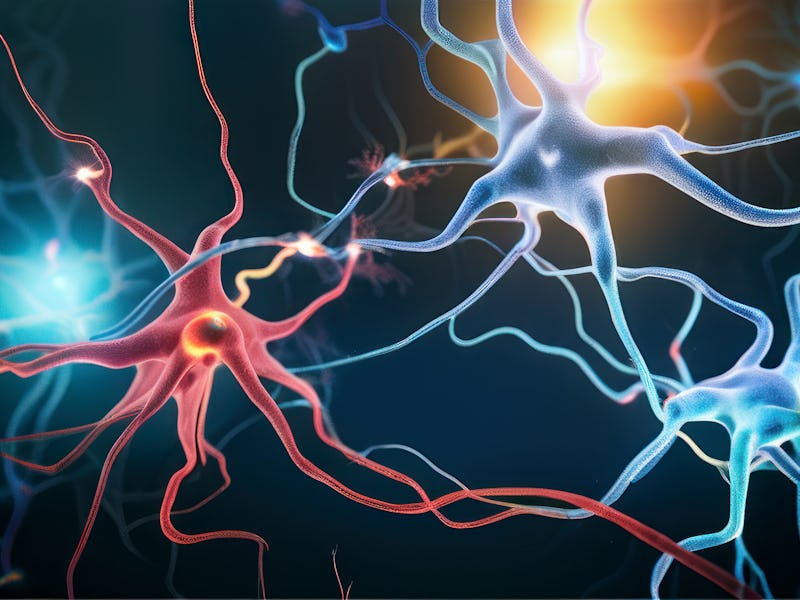A Newly Discovered “Hybrid” Brain Cell Could Transform How We Treat Neurodegenerative Diseases
Researchers uncovered a cell that’s a hybrid between a neuron and an astrocyte, and it could change how we study the brain.

The field of science is littered with epic debates. But every so often, those dogmatic clashes yield fruitful new discoveries. Case in point: Some scientists believe they’ve discovered a new brain cell.
In a study published Wednesday in the journal Nature, a team of researchers at the University of Lausanne (UNIL) in Switzerland uncovered a cell that’s a hybrid between a neuron and an astrocyte, a non-neuronal glial cell critical for protecting and supporting neurons in both the brain and spinal cord. The researchers found that these hybrid cells appeared to be specific regions of the brain, not exactly spread out like astrocytes normally are, and are capable of producing the neurotransmitter called glutamate, which controls how active and excited a neuron can get.
"In between neurons and astrocytes, we now have a new kind of cell at hand. Its discovery opens up immense research prospects,” Andrea Volterra, the paper’s senior author and a neuroscientist at UNIL, said in a press release. “Our next studies will explore the potential protective role of this type of cell against memory impairment in Alzheimer's disease, as well as its role in other regions and pathologies than those explored here."
To glutamate or not to glutamate
In their protective and supportive role, astrocytes are responsible for keeping glutamate, a neurotransmitter, in check within the central nervous system (i.e., the brain and spinal cord). Glutamate is one of the most important and widespread neurotransmitters, and it plays several crucial roles in neuronal communication and brain function. For example, it activates and excites neurons and plays a pivotal role in learning and memory by strengthening neural connections.
Neuroscientists have long suggested that astrocytes may actively participate in neural communication and information processing since they, too, can release glutamate. When astrocytes release glutamate quickly at hyperlocalized sites, they can influence how neurons communicate, change their connections, and even cause some neuropsychiatric conditions. However, the problem was that scientists weren’t sure if astrocytes really release glutamate in this manner because there have been mixed results in previous studies.
In the new study, the researchers considered whether astrocytes in the brain might have slight differences.
First, they looked for astrocytes capable of producing glutamate in samples of mouse brains using a technique called single-cell transcriptomics, a molecular biology tool that allows scientists to study the gene expression profile of individual cells. They discovered that a community of astrocytes was capable of chucking glutamate.
“We also identified other specialized proteins in these cells, which are essential for the function of [transporting glutamate out] and their capacity to communicate rapidly with other cells," Ludovic Telley, a study co-author and assistant professor of neuroscience at UNIL, said in the same press release.
But could these hybrid cells actually influence neural communication and information processing? Using this special imaging technique, the researchers watched glutamate being released in the brain tissue of live mice and saw that hybrid cells could indeed release glutamate quickly in specific areas that look like where neurons talk to each other.
The researchers found that when they genetically edited out the specialized proteins, called vesicular glutamate transporter (or VLGUT), which these specialized astrocytes use, it impaired mousy memories by interfering with neural circuits like the cortico-hippocampal circuit.
New cell, new brain insights?
Astrocytes have been implicated in a wide range of neurodegenerative and neuropsychiatric diseases like Alzheimer’s and Parkinson’s, as well as bipolar disorder.
The discovery of this hybrid cell, despite being a small group, will hopefully flesh out our understanding of how the brain works and could be used as a target for the treatment of various neurological conditions, the researchers write in the paper.
It is important to note, however, that these findings are largely based on the mouse brain models. Although glutamate and VGLUT are indeed present in humans, this would need further validation in human-based studies.
In the future, researchers hope to create maps of where these special astrocytes are located in the entire central nervous system and figure out more about what exactly they do and how they might be involved in different brain disorders.
This article was originally published on